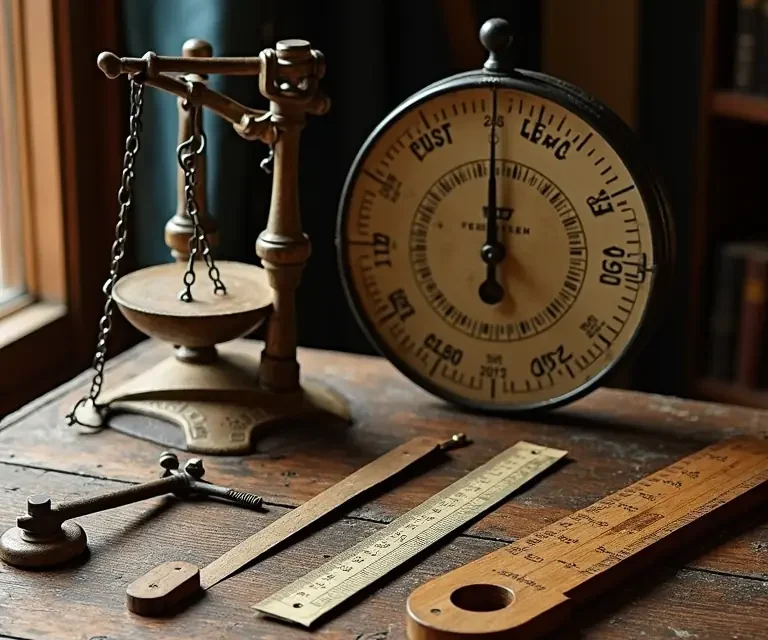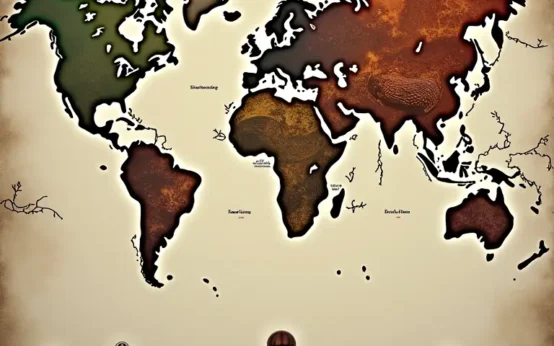We often take for granted the simple act of buying fabric. A yard, a meter, a few inches – these units feel universally understood and fixed. But delve into the history of how fabric was measured, and you’ll find a surprisingly complex and delightfully quirky world of ‘ells’, ‘naps’, ‘quarters’, and a constant struggle for standardization. This isn’t just about dusty old units; it’s a window into trade, social structures, and the very way people understood their world.
Before Standardisation: A Local Affair
For centuries, measurement wasn’t the neat, consistent system we know today. It was intensely local. Every town, and sometimes even every merchant, could have their own interpretation of a ‘yard’ or an ‘ell’. This wasn’t malicious; it was simply a reflection of how measurement evolved organically. Early units were often based on the human body – a hand, a foot, a cubit (the distance from elbow to fingertip). These were readily available, but inherently variable. Your ‘foot’ is likely different than mine, and certainly different than someone’s from the 16th century!
The ‘ell’ is a particularly fascinating example. It’s believed to derive from the Old English ‘æl’, meaning ‘arm’s length’. However, the definition of an arm’s length varied wildly. The Flemish ell, used extensively in the cloth trade, was longer than the English ell. There was a ‘cloth ell’ and a ‘linen ell’ even within England, each with slightly different lengths. This meant that a piece of cloth described as ‘ten ells’ in Flanders would be considerably larger than the same ‘ten ells’ sold in London. Imagine the confusion for merchants!
Other regional variations abounded. The ‘nap’ was used in England for measuring linen, and its length differed depending on the region. The ‘quarter’ was another common unit, again varying in size. These variations weren’t accidental. They often reflected local traditions, the types of goods being traded, and even political power dynamics. A powerful town could impose its measurement standards on surrounding areas, influencing trade and economic activity.
The Cloth Trade and the Need for Order
The burgeoning cloth trade, particularly from the medieval period onwards, dramatically highlighted the need for greater standardization. Cloth was one of the most important commodities, and disputes over measurement were common and costly. Merchants needed a reliable way to calculate prices, ensure fair dealings, and avoid accusations of short measure.
The medieval guilds played a crucial role in attempting to establish some order. Guilds, associations of craftspeople, set rules for their members, including standards for weights and measures. Guild halls often housed official measures, carefully guarded and used to verify the accuracy of merchants’ scales and measuring tools. However, even guild-imposed standards weren’t always consistent across different guilds or regions.
The complexities of the cloth trade also led to the development of specialized measuring tools. The ‘yardstick’ – a rigid rod representing a yard – became essential. But even these yardsticks weren’t uniform. Different materials were used (wood, metal), and the accuracy of their construction varied. Merchants often carried their own yardsticks, and disputes could arise over which one was ‘correct’.
The Rise of the Yard and the Influence of Royalty
The yard, despite its own fluctuating history, gradually emerged as a more widely accepted standard. Its origins are thought to lie with the Normans, who brought their own measurement systems to England after the conquest of 1066. King Henry I, in the early 12th century, is credited with standardizing the yard based on his own arm’s length – a somewhat arbitrary, but influential, decision. This “Royal Cubit” became the basis for the English yard.
However, even with royal decrees, standardization wasn’t immediate. Local customs persisted, and enforcement was often lax. Throughout the medieval and early modern periods, successive monarchs issued proclamations and laws aimed at establishing uniform weights and measures. These laws often involved the creation of official ‘standards’ – physical objects representing the correct yard, pound, or gallon – which were deposited in central locations for public reference.
The development of the ‘weigh house’ was another important step. These were official buildings where goods were weighed and measured by appointed officials, ensuring compliance with the law. Merchants were required to bring their goods to the weigh house for certification, and penalties were imposed for those found to be using inaccurate measures.
The Metre and the French Revolution: A Radical Shift
The late 18th century saw a radical shift in thinking about measurement with the French Revolution. The revolutionaries, seeking to break with the old order, embraced the Enlightenment ideals of reason and universality. They believed that a new, rational system of measurement was essential for progress.
This led to the creation of the metric system, based on the decimal system and defined by natural constants – the Earth itself. The metre was originally defined as one ten-millionth of the distance from the North Pole to the Equator. This was a revolutionary concept. It was no longer tied to a king’s arm or a local custom; it was based on objective, scientific principles.
The adoption of the metric system wasn’t immediate or universal. Britain, for example, resisted its adoption for many years, clinging to its traditional units. However, the advantages of the metric system – its simplicity, consistency, and scientific basis – gradually became apparent.
The metric system’s impact on the fabric trade was profound. It provided a clear, unambiguous standard for measuring cloth, simplifying trade and reducing disputes. The adoption of the metric system also spurred the development of more accurate measuring tools, such as precision rulers and measuring tapes.
Standardisation Beyond Measurement: Time and Travel
The drive for standardization wasn’t limited to weights and measures. The 19th century saw a broader movement towards standardization in various aspects of life, including time and travel. The introduction of standard time zones, for example, was driven by the needs of the railway industry.
The development of standard road signs and railway gauges also reflected this trend. These efforts aimed to create a more efficient and interconnected world, facilitating trade, travel, and communication. You can learn more about the history of standardization in travel through the evolution of road sign systems.
The Legacy of Historical Units
While the metric system is now dominant in most parts of the world, the legacy of historical units persists. Many English-speaking countries still use inches, feet, and yards alongside metric units. And even within the metric system, some units – like the centimetre – retain a connection to historical measurement traditions.
Moreover, understanding historical weights and measures provides valuable insights into the past. It helps us to interpret historical documents, understand trade practices, and appreciate the challenges faced by people in earlier times. The seemingly simple act of measuring cloth was, in fact, a complex and fascinating endeavor, deeply intertwined with social, economic, and political forces.
Beyond Fabric: Standardization in Other Crafts
The quest for standardization wasn’t unique to the fabric trade. Similar efforts were underway in other crafts and industries. The standardization of building materials, for instance, was crucial for the construction of large-scale infrastructure projects. The consistent geometry observed in nature, like bird nests, even hints at inherent patterns and preferences for certain proportions. The careful proportions found in ancient buildings, explored in ancient architecture, show a desire for harmony and order. Even the art of calligraphy, despite its artistic freedom, relies on precise measurements and established rules.
The Symbolic Weight of Knots and Cultural Consistency
Interestingly, even seemingly arbitrary cultural practices like knot-tying demonstrate a surprising degree of consistency across different cultures. The symbolism of knots, for example, often revolves around themes of connection, eternity, and protection, appearing in various forms across diverse societies. This suggests a deep-seated human need for order and meaning, extending beyond purely practical concerns like measurement.
Conclusion: A Story of Human Ingenuity and the Pursuit of Order
The story of historical weights and measures for fabric is more than just a tale of inches and ells. It’s a story of human ingenuity, the challenges of trade, and the enduring quest for order and standardization. From the variable ‘arm’s length’ of the ell to the universal precision of the metre, this history reveals a fascinating glimpse into the evolution of measurement and its profound impact on our world. It reminds us that even the most seemingly mundane aspects of our lives have a rich and complex history, waiting to be explored.


 The Curious Acoustics of Historical Echo Chambers: Resonance, Ritual, and Revelation
The Curious Acoustics of Historical Echo Chambers: Resonance, Ritual, and Revelation  The Curious Cartography of Scent: Mapping Perfume Ingredients Through History
The Curious Cartography of Scent: Mapping Perfume Ingredients Through History  The Curious Lexicon of Lost Trades
The Curious Lexicon of Lost Trades  The Surprisingly Consistent Science of Historical Ice Harvesting – A Frozen History of Commerce & Preservation
The Surprisingly Consistent Science of Historical Ice Harvesting – A Frozen History of Commerce & Preservation  The Unexpectedly Consistent Science of Historical Buttonhooks – Fashion, Function & Forgotten Tools
The Unexpectedly Consistent Science of Historical Buttonhooks – Fashion, Function & Forgotten Tools  The Surprisingly Consistent Science of Historical Toy Soldiers – Miniature Warfare, Materials & Collective Play
The Surprisingly Consistent Science of Historical Toy Soldiers – Miniature Warfare, Materials & Collective Play